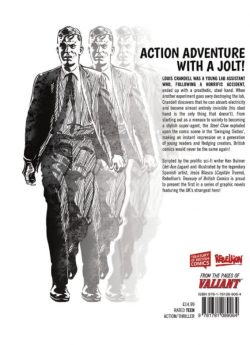

By Ken Bulmer & Jesús Blasco (Rebellion)
ISBN: 978-1-78108-906-4 (TPB)
One of the most fondly-remembered British strips of all time is the startlingly beautiful Steel Claw. From 1962 to 1973the stunningly gifted Jesús Blasco and his small studio of family members thrilled the nation’s children, illustrating the angst-filled adventures of scientist, adventurer, secret agent and even costumed superhero Louis Crandell.
The majority of the character’s career was scripted by comic veteran Tom Tully, but initially follows the premise of HG Wells’ original unseen adversary as prolific science fiction novelist Ken Bulmer devises a modern spin on the Invisible Man…
Another stunning salvo of baby boomer nostalgia from Rebellion’s Treasury of British Comics strand, this first collection is available in paperback and digital editions. The Steel Claw: Invisible Man gathers material from timeless weekly anthology Valiant, spanning 6th October 1962 to 21st September 1963 and stories from the Valiant Annual 1965 and 1966.
Following an Introduction from Paul Grist, the tense drama begins with our eventual hero debuting as a rather surly assistant to the venerable Professor Barringer, working to create a germ-destroying ray.
Crandell is an embittered man, possibly due to having lost his right hand in a lab accident. After his recovery and itsreplacement with a steel prosthetic he is back at work when the prof’s device explodes. Crandell receives a monumental electric shock and is bathed in radiation from the ray-device which, rather than killing him, renders him totally transparent. Although he doesn’t stay unseen forever, this bodily mutation is permanent. Electric shocks cause all but his metal hand to disappear.
Kids of all ages, do not try this at home!
Whether venal at heart or temporarily deranged, Crandell goes on a rampage of terror against society and destruction of property throughout Britain which culminates in an attempt to blow up New York City before he finally coming to his senses. Throughout Crandell’s outrages, Barringer is in guilt-fuelled pursuit, determined to save or stop his former friend…
The second adventure channels another classic (The Strange Case of Dr Jekyll and Mr Hyde), intriguingly pitting the Claw against his therapist, who – in an attempt to treat him – is also traumatically exposed to Barringer’s ray. Instead of permanent invisibility, Dr. Deutz develops the ability to transform himself into a bestial ape-man who malevolently turns to crime and frames Crandell for a series of spectacular robberies and rampages.
On the run and innocent for once, Crandell is saved by the intervention of Barringer’s niece Terry Gray. After weeks of beast-triggered catastrophe and panic in the streets, the Steel Claw is vindicated and proved a hero… of sorts…
Bulmer’s next tale changes location to the Bahamas as our star shifts from outlaw to hero. While recuperating on an inventor-friends yacht, Crandell is accidentally embroiled in a modern-day pirate’s attempt to hijack an undersea super-weapon system…
After would-be bullion bandit Sharkey and his nefarious gang steal the device and use it to capture a submarine, their convoluted scheme to rob an ocean liner falters when a steel fisted ghost starts picking them off one by one…
More than any other comics character, the Steel Claw was a barometer for reading fashions. Starting out as a Quatermass style science fiction cautionary tale, the strip mimicked the trends of the greater world, becoming a James Bond-style super-spy strip with Crandall eventually tricked out with outrageous gadgets, and latterly, a masked and costumed super-doer when TV-show-triggered “Batmania†gripped the nation and the world. When that bubble burst, he resorted to becoming a freelance adventurer, combating eerie menaces and vicious criminals. Before we head too far down that path however, his contributions to Valiant Annuals 1965 and 1966 (released Autumn 1964 and 1965 respectively) afford rather more constrained thrills and chills as Crandell defeats a gang using an electricity-supressing gadget to rob a blacked-out London and one year later aid the Metropolitan police force corral a bunch of apparently invisible bandits dubbed the Phantom Raiders…
The thrills of the writing are engrossing enough, but the real star of this feature is the artwork. Blasco’s captivating classicist drawing, his moody staging and the sheer beauty of his subjects make this an absolute pleasure to look at. Buy it for the kids and read it too; this is a glorious book, and brace yourself for even better yet to come …
© 1962, 1963, 1965, 1966 & 2021 Rebellion Publishing IP Ltd. All Rights Reserved.
